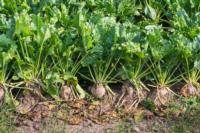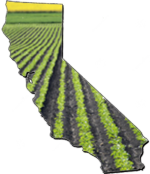
Sugar beet (Beta vulgaris, L) is a biennial plant. In the first year, it produces an enlarged root and hypocotyl, storing sucrose that provides energy used to flower in the next season. Sugar beet is typically cultivated in the northern temperate zones, between 30° and 60°, where it is primarily a spring-planted crop. There are also cultivation areas in the southern temperate zones, including Chile, Venezuela, and Uruguay. It also can be cultivated as a winter crop, “winter beet” (planted in the autumn and harvested the next summer) in Mediterranean regions and some arid tropical and sub-tropical areas if irrigation water is available or rainfall is sufficient.
Although domestication of beet as a leafy vegetable and root crop took place in prehistoric times, sugar beet is a relatively new crop plant. The European beet sugar industry was able to develop once the technology to measure sucrose concentration in solution was discovered, and the spread of this industry was accelerated by increased demand for beet sugar caused by the British blockade of continental Europe in the early 19th century. Starting in France and Germany, the beet sugar industry spread throughout Europe to North and South America, Asia, and North Africa.
About 35% of global sugar production and 50-55% of domestic (U.S.) sugar production comes from sugar beet, equating to about 8.4 million metric tons (4). Some sugar beets are currently used for fuel ethanol production. Technically, conversion of sugar to ethanol is a simple process requiring only yeast fermentation, whereas producing ethanol from maize, e.g., requires enzymes to convert starch to sugars.
Origin and History of Sugar Beets

Sugar beet (B. vulgaris spp. vulgaris, L.), a genus of the family Amaranthaceae (formerly Chenopodiaceae), is one of the diverse and useful group of cultivars from the same species that includes Swiss chard, fodder beet, and red beet. The first modern sugar beets originated as selections made in the middle of the eighteenth century from fodder beets grown in then German Silesia, but food and medicinal uses of the genus are much older. A precursor is known to have been used as food as early as dynastic times in ancient Egypt. The beet industry continued to expand in Europe, which remains the center of the industry, and developed in other countries in the Middle East and North Africa; Central Asia and Japan; and North and South America. The first successful commercial factory in the United States was constructed by E. H. Dyer Alvarado, in California, in 1879. Soon after, sugar beet culture and factories expanded in many states.
Sugar Beets in California
Since 1870, 11 sugar factories have been built throughout California. However, the last sugar beet factory in northern California closed in 2008, ending more than 140 years of beet production in the region and leaving only one operating in the state (in the Imperial Valley).

Several factors make possible the use of beets for biofuels in California: (1) The state’s Low Carbon Fuel Standard (LCFS)1, which is feedstock neutral and rewards efficient feed stock production financially, (2) increasing and large root and sugar yields combined with improving resource use efficiency based on new technology, (3) prospects for 12 month harvesting, and (4) the use of new transformation technology to convert beets to ethanol. Crop rotations including beets are evaluated using an economic optimization model, and greenhouse gas emissions are accounted using life cycle assessment (LCA). Together, these methods allow the economic price and location within California of areas most suitable for beet production to be determined together with regionally-specific estimates of the carbon costs of feedstock production.
